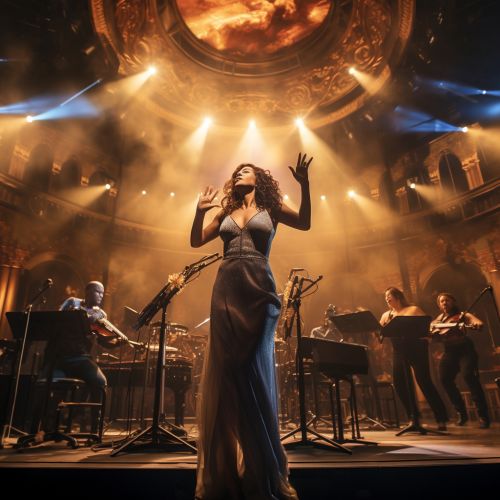Mezzo-soprano
Definition and Range
A Mezzo-soprano is a type of female singing voice whose vocal range lies between the soprano and the contralto voice types. The term 'mezzo-soprano' is derived from Italian, meaning 'half soprano'. The mezzo-soprano's vocal range usually extends from the A below middle C to the A two octaves above (A3-A5 in scientific pitch notation).
Vocal Timbre
The mezzo-soprano voice type is characterized by its warm and rich vocal timbre. This is due to the longer length of the vocal cords, which allows for a fuller and darker tone than that of a soprano. The mezzo-soprano voice is often associated with a mature, sensual, or even motherly character in opera and classical music.


Subtypes
There are several subtypes of the mezzo-soprano voice, including the coloratura mezzo-soprano, the lyric mezzo-soprano, and the dramatic mezzo-soprano. Each subtype has its own unique characteristics and is suited to different roles in opera and other forms of classical music.
Coloratura Mezzo-Soprano
The Coloratura Mezzo-Soprano is a subtype that is capable of executing rapid passages and fioritura, which are embellishments or ornaments in the music. This voice type is often cast in 'trouser roles' in opera, where a female singer plays a male character.
Lyric Mezzo-Soprano
The Lyric Mezzo-Soprano is characterized by its warm, sensual sound and is often cast in roles that require a sense of maturity or motherliness. This voice type is often used in romantic or tragic roles in opera.
Dramatic Mezzo-Soprano
The Dramatic Mezzo-Soprano has a powerful and rich voice that can project over a full orchestra. This voice type is often used in roles that require a strong, commanding presence.
Roles in Opera
In opera, the mezzo-soprano often plays a variety of roles, ranging from the heroine's best friend, the antagonist, to male characters (known as 'pants' or 'trouser' roles). Some of the most famous mezzo-soprano roles in opera include Carmen in Bizet's 'Carmen', Rosina in Rossini's 'The Barber of Seville', and Cherubino in Mozart's 'The Marriage of Figaro'.
Notable Mezzo-Sopranos
Throughout history, there have been many notable mezzo-sopranos who have made significant contributions to the world of opera and classical music. These include Marilyn Horne, Cecilia Bartoli, and Janet Baker, among others.
Training and Technique
Training a mezzo-soprano voice involves a focus on breath control, vocal agility, and the ability to sing in a variety of languages. It is also important for a mezzo-soprano to develop a strong sense of musicality and dramatic interpretation, as these skills are often required in the roles they perform.
